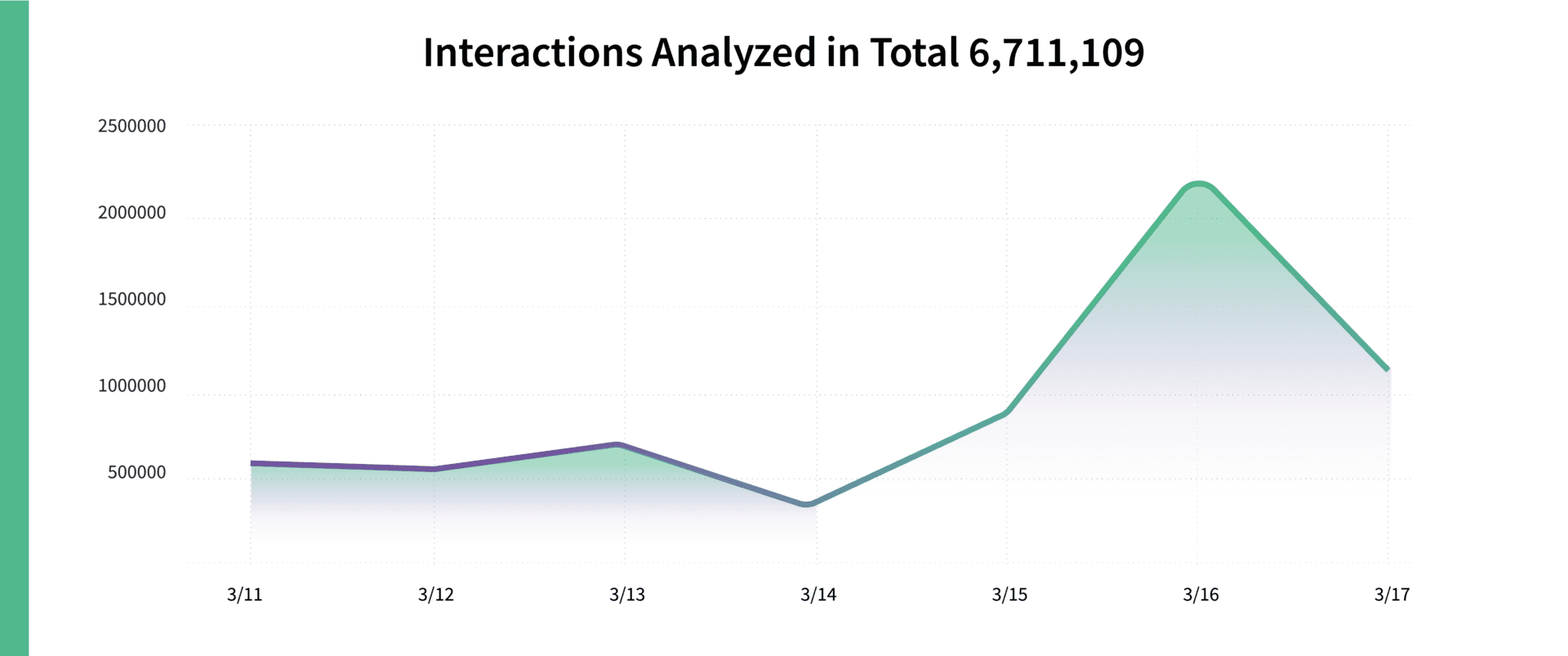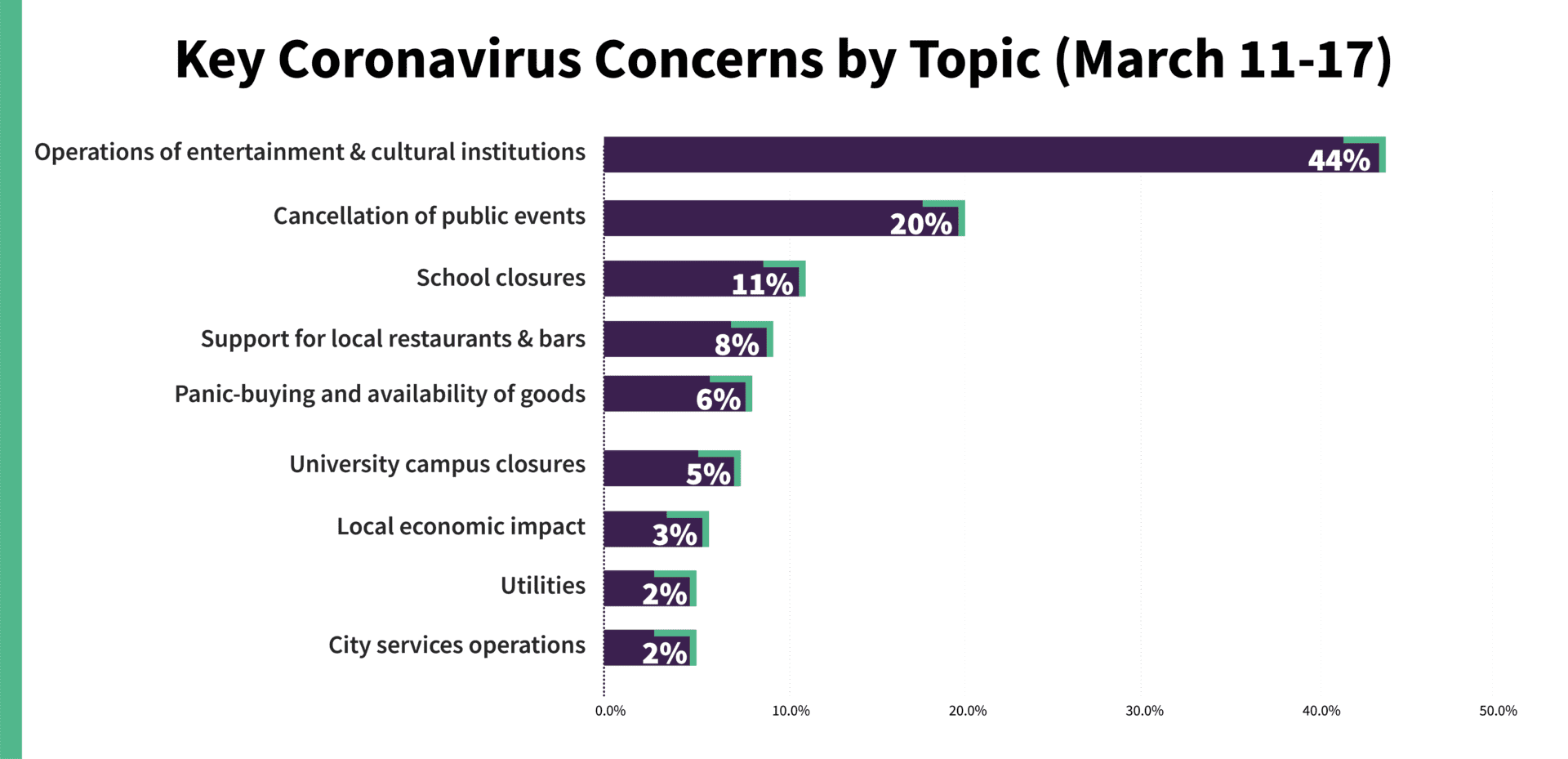Coronavirus in U.S. Cities: Residents’ key concerns in numbers
.png)
Zencity
The Platform for Community Trust
The coronavirus outbreak is completely changing day to day realities across the world, and fast. As more cities announce positive cases, create new policies, and implement different measures, the concerns of their communities change as well. And we can see that manifest itself in online conversations.
Last week we released a report, which analyzed over 1.5M online data points from the first week of March, and highlighted the key concerns of communities in over 100 cities across the US regarding COVID19. Our goal with this report was to aid local government teams- the men and women on the frontlines of the COVID-19 outbreak- to efficiently identify their community’s needs and better shape their crisis response, policies, and messaging. (See best practices for effective messaging here).
But as the crisis continues to unfold, there is an acute need for updated, relevant data to support these big decisions. And that is why we’re sharing this new, updated version, analyzing 6.5M online interactions from this past week.
While in our previous report we found residents were most concerned with school closures (over 42% of the comments), this week’s data paints a different picture, and we see noteworthy variations in discourse topics as the COVID-19 becomes the “new normal”.
Residents Key Coronavirus Concerns (March 11-17)

First let’s touch on the sheer quantitative growth in online discourse. An underlying difference between our analysis this week versus the first week of March is in the number of online interactions that we analyzed. In the first week of March, we gathered 1.5M data points, while from March 11-17th we gathered over 6.7M interactions about COVID-19. Specifically, we saw a significant peak in online discourse within the last three days of our analysis, from March 15th to the 17th.
While this is not surprising, it is a dramatic increase. We know that everyone is talking about the pandemic. But what are residents actually concerned with this week aside from the topic of public health? How do residents believe the outbreak will impact their day to day and what are they voicing online? By using topic modeling and clustering, we were able to obtain answers to these essential questions.

As we can see, the main topics of concern changed significantly from last week, with cultural institutions becoming the leading topic, and schools dropping to account for only 11% of the discourse.
Below we’ve provided a more in-depth analysis of the above graph and essential takeaways on what residents are saying.
Entertainment and cultural institutions:
The most prominent cause of uncertainty and concern within communities across cities was the topic of entertainment institutions, such as museums and theaters, that are cancelling performances and/or closing operations for the time being. Residents also discussed institutions that distributed notices about remaining open. Most residents expressed joy and gratitude towards those particular entertainment institutions and asked whether their operations would be adjusted to accommodate social distancing practices and CDC guidelines. As this topic becomes more of a focus across the U.S., even Insider decided to highlight what some theaters are doing in order to stay open.
Festivals and Public Events:
The second major topic of concern for residents in association with COVID-19 was about cancellation of city and non-city run events. Residents also wondered why some events were cancelled why others remained scheduled as planned, and sought out clarification. In some cases (especially when the festivals were poised to have considerable positive impact on the local economy) there was objection and concern about the economic toll that the cancellation would have on the community. Overall, most cancelations were well-received by residents.
Schools:
Now that school closures have become the standard across the U.S., the discourse volume in this category has dropped compared to our first week of analysis. Conversations within the category have also now shifted focus to arrangements for remote learning (access to internet) and initiatives for providing meals to school children. Residents also expressed concerns about children disobeying social distancing and gathering outside of school in groups. Furthermore, many working parents in particular, voiced their worry about access to childcare arrangements. On the flipside, many students voiced their disappointment regarding canceled games and after school activities. Despite residents taking to the internet to share their worries about the impact of school closures on their daily routines, the act of closing schools was generally favored by communities.
Local Restaurants and Bars:
A lot of the online chatter regarding local restaurants and bars consisted of updates about which businesses are operating and offering delivery, curbside pickup, and/or online orders. Many cities are proactively aiding restaurants and bars by advertising that they are still running and even assisting operationally to accommodate the high demand for deliveries and pickups. While dining rooms are closing across the county, boxed meals and inspiring solutions are abundant. In particular, online discourse is proving to be critical in aiding residents, cities, and businesses get the word out to help salvage restaurants and bars. However, some of that online discourse also consists of young people who do not want to abide by social distancing recommendations and believe that the best way to aid restaurants and bars is to continue to go out in public and support these local establishments.
Panic-buying and availability of goods:
There’s a science behind panic-buying during an epidemic. As Amy Mckeever of the National Geographic notes, “Panic-buying supplies is one way humans have coped with uncertainty over epidemics since at least 1918 during the Spanish flu—when people in Baltimore raided drug stores for anything that would prevent the flu or relieve its symptoms—all the way up to the 2003 SARS outbreak.”
“When you’re seeing extreme responses. It’s because people feel like their survival is threatened and they need to do something to feel like they’re in control,” explains Karestan Koenen, professor of psychiatric epidemiology at the Harvard T.H. Chan School of Public Health.
Accordingly, with coronavirus uncertainties swarming online we are seeing a continuation of discourse about stockpiling and panic-buying. Yet residents aren’t just expressing “panic” online. Many have taken to the internet in response to the pictures of empty shelves and the fights over toilet paper to discourage their fellow community members from panic-buying and encourage consideration of those who are truly in need of the resources. Police and law enforcement communications also occupied the discourse, with formal warnings to residents about scams by those who are trying to capitalize on public anxiety.
Additional Concerns of Residents:
While the following concerns did not represent a significant percentage of the discourse data, there is a chance that we can see these concerns become more pronounced in the coming week or even in the next few days. Thus, we thought it would be worthwhile to note them below:
- Closing campuses and dorms – residents actively discussed the topic of arrangements for students that have nowhere to go due to these campus closures
- A portion of residents had questions about the continuation of city services such as community centers and libraries. Considering these concerns, some libraries for example, have begun to offer online books or wave late return fees
- Residents were also concerned about the potential shutting off of utilities such as water and electricity. As a result, some local governments distributed messaging emphasizing that they would halt any disconnections or shut-offs for the time being.
We hope this report aids local government professionals as they work tirelessly to manage the coronavirus crisis in their communities. Be on the lookout for our updated insights for the week of March 18th to the 24th.
Zencity also released a short one-pager describing main ways its 120 partner network leverages the platform in light of the coronavirus crisis. You can read the full resource here:
TLDR
From our analysis, we were able to extract these essential takeaways from residents’ online discourse:
- Speculation about school closures had occupied over 42% of the community discourse in the first week of March and has now dropped to only 11%
- With school closures having become the new normal, discourse has now shifted to a focus on how to cope with this reality (e.g. access to online learning, meals, and childcare).
- There was less of a focus on the sanitation of public transportation and its relation to the transmission of the virus compared to the previous week. We believe that this is due to the fact that many cities have shut down public transportation and that residents have begun to self-isolate/remain at home
- There is still lack of clarity within communities about the status of events and what is permissible in terms of going out in one’s city (e.g. inconsistency of event cancellation, CDC guidelines for leaving the home).
- Also, the new restrictive policies to deter transmission have engendered significant distress regarding the economic impact on businesses and individuals. These concerns have sparked helpful initiatives led by the city, other businesses and the community
- Overall people have shifted from discussing the dawning of the outbreak and are now more focused on discussing life as it continues against the backdrop of the ongoing crisis: food delivery, family services, going out, making a living, paying bills, etc.
- At first, the practice of social distancing had a fair amount of opposition, yet now we see more acceptance of this preventative method, which is reflected in attempts by residents to maintain a semblance of normalcy under this new paradigm.
Diving deeper into residents’ online discourse, Zencity analyzed over 86M social media data points to unveil how Coronavirus has changed the way cities and residents communicate. Discover insights on leading channels, engagement statistics and more here.
%20copy-1.png?width=544&height=120&name=Logo_black%20(1)%20copy-1.png)



